Gave my neighbor some Snow Queen nectarines from our tree the other day and she sent me this text: “Greg, those nectarines were by far the most delicious things we have had in our entire life.”
Now, my neighbor is really friendly, and maybe she just wanted to emphasize gratitude, but I was eating one the other day — juice dripping on my toes — and was also thinking, “These Snow Queens are out of this world right now! I have to write a profile post on this variety.”
Harvest season
This year, the Snow Queen harvest is peaking here in early to mid July, but this is slightly later than usual. Late June to early July is the usual.
To put the Snow Queen harvest season in context, I can say that they are later than the Eva’s Pride peaches in my yard, slightly later than the Blenheim apricots; and Snow Queen nectarines are slightly earlier than Splash pluots, almost a month earlier than Red Baron peaches.
In fact, I’ve got a few branches of Red Baron grafted onto my Snow Queen tree so you can easily see the difference in maturity between those two.
(See where the Snow Queen harvest fits in among many other deciduous fruit trees in the Dave Wilson Nursery Harvest Chart.)
Tree characteristics
Snow Queen bears attractive pink blossoms in the spring, but these do not match the showy double flowers of Red Baron (which open earlier than Snow Queen despite the Snow Queen fruit’s earlier maturity, oddly).
Snow Queen nectarine trees don’t need much chilly weather in the winter in order to flower and fruit well. My tree located in the foothills of San Diego County has performed fairly consistently over the past seven years. I’ve seen Snow Queen trees in warmer locations closer to the ocean fruiting well also. One nursery grower of Snow Queen trees lists the chill hours needed for this variety at 250, and most Southern California locations at least a couple miles away from the coast average that many or more.
However, I wasn’t convinced my Snow Queen was a keeper during its first couple years because many of its nectarines split on the young tree.
Now, in all years but those with the warmest and wackiest winters, my mature Snow Queen nectarine tree has been a reliable producer of unsplit, high-quality fruit.
(My tree is on Nemaguard rootstock, by the way.)
A Snow Queen nectarine tree is similar to almost every other nectarine tree in that it will fruit without any other fruit trees nearby. It’s self-fertile, as they say.
Strengths and weaknesses
I have seen many other varieties of peaches and nectarines in my yard get peach leaf curl worse than the Snow Queen. Not that the Snow Queen is immune, but it certainly isn’t as susceptible as many other varieties.
While the Blenheim apricot next to my Snow Queen nectarine gets some sunburn on its fruit if we have an early summer heat wave, the Snow Queens never do. Snow Queen seems like a tree that would possibly even suit a desert location.
On the other hand, Snow Queen fruit do tend to have some blemishes, primarily skin-deep blemishes. For example, they get bronze speckling that is sometimes so heavy as to be more like russeting. Fortunately, this doesn’t affect the fruit’s interior.
Like other nectarines, Snow Queens do get some scarring from Western flower thrips (Frankliniella occidentalis) — worse in some years, very little here in 2021. I don’t do anything to try to control this, as there is always enough fruit on the tree to just thin those with a lot of thrips scarring, as it is occasionally so bad as to deform fruit. (See the UC IPM page on Western flower thrips management on nectarines.)
I get a lot of doubles and spurs on my Snow Queen in some years, where two fruit grow connected near the stem. But again, because the tree is so productive I can usually thin these doubles and spurs and still have more wholesome fruit on each branch than it can handle so it’s not a significant problem.
(It is written in The Home Orchard that doubles and spurs are caused by high temperatures during the previous summer.)
Eating qualities
When the background color of a Snow Queen nectarine turns from green to white, it’s ready to pick, and if you let it go all the way white, even cream colored, then it’s the juiciest piece of fruit you can ask for. It can be like biting into an extremely sweet water balloon.
But what I like about the sweetness of Snow Queen is that it always retains a bite, a tang in the background such that it’s not a bland sugariness. Snow Queen has a rich, rounded flavor.
(Stick your head into a Snow Queen tree and you can smell the same aroma.)
The interior of the fruit is nearly white, and the flesh comes off the seed pretty well. I’ll call it semi-freestone.
History
Snow Queen is not a new, untested nectarine variety. It was introduced half a century ago by Armstrong Nurseries of Ontario in San Bernardino County. (All of us in Southern California know Armstrong — none of us live far from an Armstrong Garden Center today.)
Snow Queen has proven itself worth growing in my yard and in many other yards in our region. As with any variety, Snow Queen is not perfect, but I appreciate my tree more as the years pass. As do my neighbors.
All of my Yard Posts are listed HERE

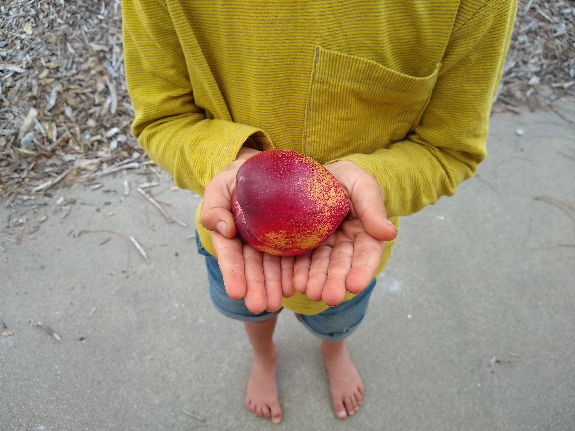
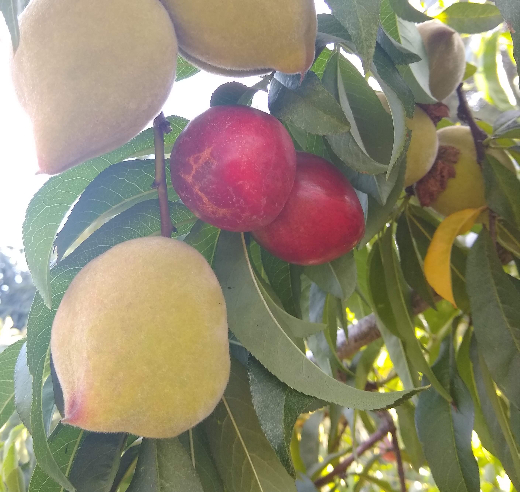
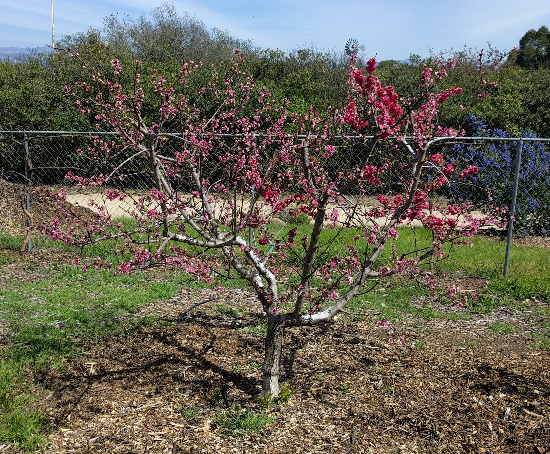
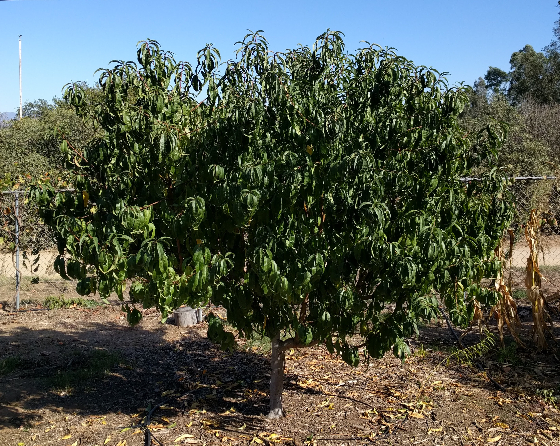
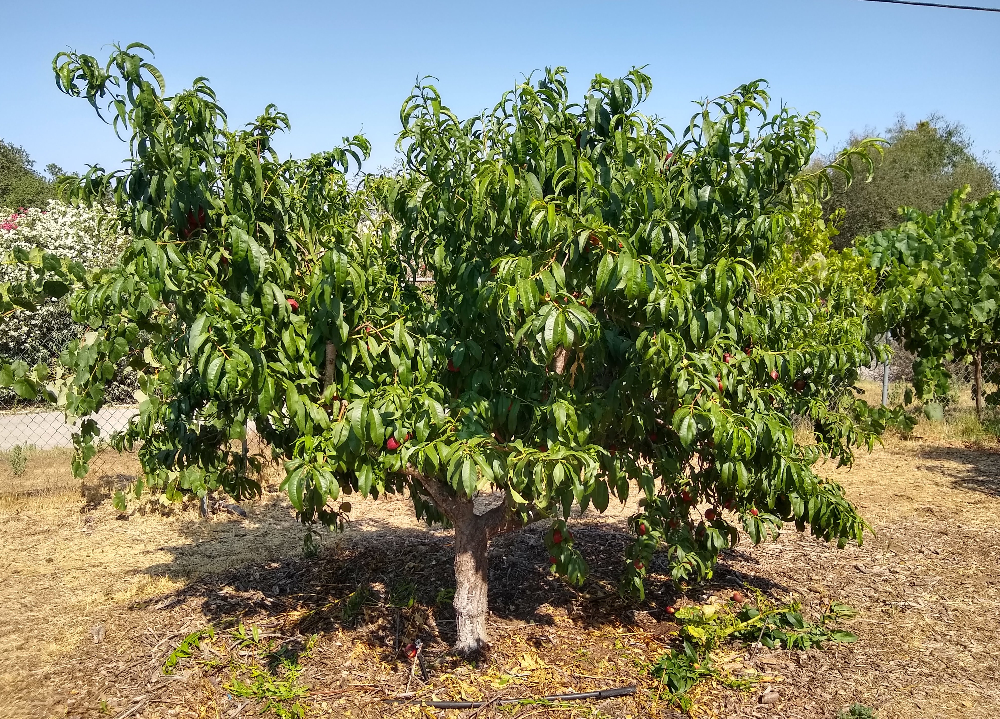
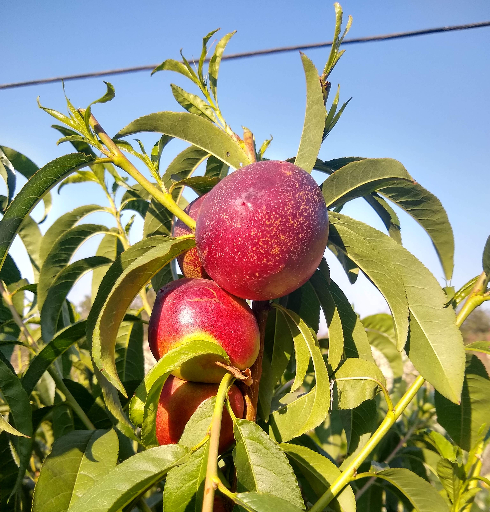

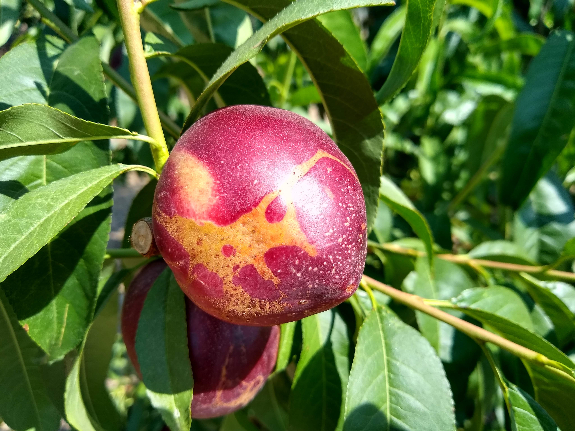

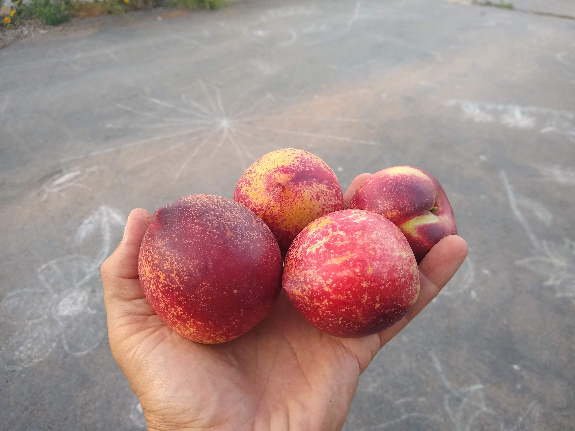
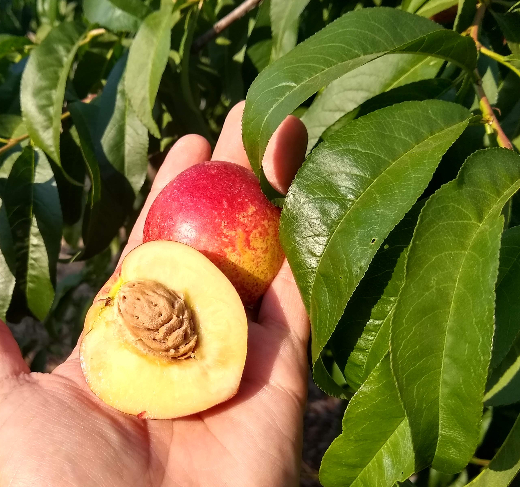


I just planted a bare root Snow Queen nectarine tree last year and got our first harvest this month. Not a large harvest but so delicious and the tree has grown so much. I have a mid-Pride peach right next to it that isn’t doing so well and was thinking about spraying it in case it has Peach Leaf Curl, would you recommend not spraying the nectarine?
Hi Mika,
If your Mid-Pride peach has leaf curl it will be very obvious by looking at the leaves. But spraying for it must be done before the leaves show symptoms. See this post with more on peach leaf curl and my own practices with regard to spraying for it: https://gregalder.com/yardposts/dormant-spray-deciduous-fruit-trees/
Thank you, you post is super helpful.
I bought my Snow Queen from Armstrong Garden Center in Temecula. It has been my pride and joy. It produced it’s first summer and and been a heavy producer ever since, and the flavor is out of this world! Now if I could just get my Hass avocado to take a lesson from her…
SAME! I had someone point out that there are A and B type avocados and that they recommend planting one of each type to ensure you get fruit, so I think I will be planting a B type to try and get my Hass to produce fruit.
Those Snow Queens look wonderful. If I were your neighbor I would offer free weeding for life and enjoy the spoils. Love the posts and your fantastic bits of insight on all things in the garden. Looking forward to more.
Snow Queen is a must have along with Cotton Candy Aprium and Nectaplum.
Are you growing those two varieties? Would you share for tastes testing with us?
Greg – About how long is the Snow Queen season in your area?
Hi Dal,
My notes say that the first fully ripe and tasty Snow Queen this year was on July 3. Here on July 19 it looks like I’ll still have some to pick for another week or so. That’s about 3 weeks of prime harvest with about another week on either end of slightly immature or overmature fruit still hanging.
But we haven’t had a heat wave during harvest this year. When we do, the harvest window is concentrated.
Wish I was your neighbor!
Very nice, Greg! Glad you had a good harvest. My Snow Queen fruit have been great this year as well. However, my Arctic Star nectarine and Mid-Pride peaches so far have been the star of the show this year for us. Both were superb, but the Arctic stars were phenomenally great! We harvested bucket loads of both varieties.
I have never tasted nectarines like the Arctic Stars. Insanely sweet with a rich flavor I have never tasted. Almost like a nectarine crossed with a pluot with this distinct flavor no one could figure out. Just insanely delicious. In fact, we are going to plant a couple more of the Arctic Star trees come winter. All or most of our trees in the orchard are on Nemaguard.
Great to hear from you, Aiden. Thanks for the Arctic Star report. I like that variety too, but I don’t have a full tree of it. Maybe I need one.
Likewise, Greg! I hope you are doing well. Hope the heat is treating your plants good. It has been a wet mild summer down here in south Texas for us. I think you definitely need a Arctic Star tree. It’s a winner for sure.
Btw, the Green Gold and Jan Boyce avocado trees are doing great. Super excited.
We love our nectarines, they are my favorite stone fruit. Even starved for water, the nectarines and peaches do ok. Especially the nectarines–the young tree fruited early and often, though this was not a great year due to the drought. Now, I have more varieties to try when I make room for after removing the trees I’m giving up on … All this info is so great! ??
I don’t see our water usage increasing much. We’ve piped an outdoor shower to our bed of lavender. The guest outdoor shower is going to drain into some fruit trees. Plumbing done, need to finish the shower. We are experimenting.
Just checked, and our nectarine is Desert Delight. If other varieties are known for more tastiness, I’m in for a treat. Even a low water environment such as this just concentrates the delicious flavor of these.
So, last year after reading this article, I promptly ordered a Snow Queen nectarine tree. It was, and is still a tiny, spindly little thing but had tons of flowers and developed 12 whole gorgeous fruits, none of which split. (I’m in Claremont, super hot summer and no frosts last winter). I agree with your neighbor – they were the most delicious fruit I’ve ever eaten! I had carefully tied a little green organza bag around each one to protect them from birds, Japanese beetles, squirrels, etc. we ate 5 gave 3 to my father, who loves nectarines, and anticipated savoring the last four. But we were foiled. Overnight, a squirrel picked all four, carried them to the front yard, annd ate every last scrap right through the bags! Arg! Th was is on!
Just catching up, Greg, on your great July posts. As you have said, the Snow Queen is amazingly tastey. But unfortunately, our Snow Queen (planted as bareroot in Feb 2015) has never really grown out of the splitting problem, and I’m clueless why. (And like yours, we’ve never had a problem with peach leaf curl though our nearby Tropic Snow, Atomic Red and “Prides” have major problems.) The tree had a great bloom (with it’s delicate little blossoms) and put out great foliage, but the crop was thin and nearly every nectarine spit. (I’m in east La Mesa, and this winter in particular had a lot of cold mornings in our garden, so winter chill can’t be a factor.) Is it a problem of irrigation or fertilizer? (But our Atomic Red did great)? I’m thinking of giving it extra phosphorus in the second half of September to help bud formation and fruiting next spring. Otherwise I’d be greatful for any ideas.
Hi Greg. Just discovered your site and blog – fabulous information!
My question – what is the difference between planting bare root fruit tree versus potted fruit tree (besides price).?
I’m in Oakland CA.
Hi Suzanne,
Thanks, and great question! I tried to answer it in this post: https://gregalder.com/yardposts/bare-root-season-is-here-the-best-time-to-buy-and-plant-a-deciduous-fruit-tree-is-now/
Hi, Greg. I’m near Temecula and planted my Snow Queen as a bareroot in January 2019. We haven’t gotten any fruit yet, but 10 other bareroots planted at the same time have fruited. This is the first year it has been completely covered in flowers, but looks like most are drying up and falling off. Yard always has tons of bees (saw them buzzing around tree), butterflies and other beneficials. Also did some gentle hand pollinating to try to ensure fruit this year. All other fruit trees right next to Snow Queen that were also flowering were successfully pollinated. Not sure what’s going on. If you have any insight, it would be greatly appreciated.
I have a 7 year old Snow Queen Nectarine tree here in Menifee, CA that I got from Moon Valley Nursery last June and this year is the first winter I have had it. I see a decent amount of flowers and the beginning of leaves on some branches, but there is a whole shoot on the opposite side that has nothing yet. Do I still need to wait it out for the growth to come or should the whole tree be more or less uniform?
Just came across this thread. I also have a Snow Queen as well as a Cot-n-Candy Aprium. They were planted in 2015. The Snow Queen has looked the best it’s ever looked this year and has tons of fruit. Getting close to ripe. Just was curious how does everyone typically water the trees? Time/Days/Intervals etc. hopefully I have been watering them enough but I think the large amount of rain probably made up for it this year.
I’m thrilled to find this Post. In my yard I’m struck with how EVERYTHING looks after the ‘rivers of rain’. Here in Corona we measured 26″ of rain! My young pluouts and plum and apples are noticeably healthy, my old Avocado, I can’t remember the type, looks amazing; beautiful, full, green leaves. Blueberries did better then ever. I only just this month started the water on the orange trees. My thought is: if this is such a great response to winter water, should I consider adding an irrigation schedule to the mid winter calendar? I generally do not add water to anything except the patio flower beds and pots from about Nov-March. (depending on Mother Nature)
This is a great observation and question, Karen. I think there are many parts to the answer.
The beneficial effects of the rain are partly due to the high quality of rainwater compared to our irrigation water (which has high levels of sodium and chloride in Southern California). So with that in mind, adding winter irrigation won’t help as much as the same amount of rain.
But related to this is another reason that ample winter rains help, which is that they can leach the sodium and chloride that has built up in our soil from the dry season’s irrigation. And with that in mind, winter irrigation can help (with leaching) if the winter rain has been insufficient to do the leaching.
(Leaching with irrigation water that has high levels of sodium and chloride can still be effective because that water will still have lower levels than the soil at the end of the dry season.)
What I’ve tried to do in my yard over the years is collect rainwater from my roof and add it around my plants each winter so that they experience something like a 26-inch rainy season like you had in Corona even during the drier winters. I’ve never seen a negative consequence from this.
However, I never expect it to be as effective as a real 26-inch rainy season because I’m only adding the extra rainwater near my plants and not across my entire landscape. It appears that a real 26-inch rainy season is more effective based on how my entire landscape looks after rainy winters like this one compared to drier winters, and I think it is because rainy winters deeply water all of the soil everywhere and satiate even the native oaks and other large trees with extensive root systems.
I think that you are definitely on the right track in thinking that adding irrigation to the mid-winter calendar would be useful in drier winters.
I am a bit nuts about my rain barrels. But I only have 2 / 92 gallon which I use on the pots and planters during the winter when needed.. Unfortunately the underground rain water collection system I had planned for our house was victim of budget cuts!!! 🙁
It’s true about irrigation; when my family’s orange grove had to transition from well water to municipal water – the trees suffered so. Yellowed and stunted for a couple seasons. And I remember the grove manager telling us that the recycled water system Corona put in would not be an acceptable source for the orange trees. Too much salts. So due to the price of municipal water we had to give up the grove after a couple years. Except for 50 we kept!
I came across this chat thread today as i try to find more knowledge for my snow queen nectarine that i just picked up over the weekend from local Armstrong. All your shared experiences and comments are so helpful and exciting as I anticipate my first harvest!
I wonder if I will get fruit this June? I don’t know how old tree is; it’s about 5-6 ft tall, with little leaves but many flower buds and clipped branches. Picked it up because it was on sale without knowing its value! How exciting from what I had just read! How will you know if you will have a good harvest by June?